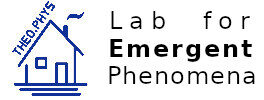Master thesis – Aakash Bhat
Aakash Bhat
Investigations of Symmetry Groups in a Finite Projective Space [PDF]
finished 2020-10
supervised by Klaus Mecke and Alexander Laska
A finite and projective geometry defined over a (d+1)-dimensional vector space is chosen as the setting for spacetime. The finite nature is endowed with the field structure of a Galois field Fp with an order p, where p is prime. The projective nature allows for a breakdown of the space into affine subspaces, such that an n-dimensional projective space has {n,n-1,…,1} dimensional affine subspaces. This breakdown has been theorized to be the reason why the SU(3)xSU(2)xU(1) symmetry might be seen in the particle fields in quantum field theory.
Our geometry consists of points and hyperplanes, such that an incidence relation may be defined over them. The entire space is covered by a biquadric field, where a biquadric is an object of the second order. Biquadrics allow for a definition of neighborhood, order, and distance measures, and are the analogs of metric tensors in the general theory of relativity. The incidence relation itself can be thought of as an invariant, such that projective transformations, which are automorphisms of the projective space, preserve the incidence. A particular subset of these transformations are the textit{Lorentz transformations}, which are the automorphism group of the biquadrics. The Lorentz group also keeps the centre invariant, and is shown to consist of boosts or rotations or both, depending upon the dimension and the quadric signature considered. After a theoretic consideration of the structure of this group we also show visually the similarity between the group of rotations, which is an orthogonal group, and the normal rotations in real or complex space, such that the finite rotations can be said to be embedded in the group of rotations in complex space. A similar visual approach shows that boosts and successive rotations can be axially- or point-symmetric, depending on the parameter.
While Lorentz Transformations have been discussed previously the same can not be said of Gauge transformations. To reach a final theory which is gauge invariant, the thesis builds upon the idea that the important considerations are twofold. The first consideration is the existence of the Local world domain. This space is a subset of the total space, such that distances (or any other second order measure) follow the same order relations as defined for a linear measure. Points outside this domain, which are still part of the spacetime, must somehow be mapped back in. This mapping defines a fiber space, such that points inside and outside successive local world domains are connected. The basic gauge invariance is then part of the degrees of freedom in choosing these mappings. Secondly, it follows from the first that one must define some sort of a mapping and look at it’s symmetries. For this we look at the intersections of quadrics. These are called hyperplanes of intersection and form the basic element of our study of symmetries of this space. A similar concept is known as Interunion and considers along with affine points also the points of intersection at infinity.
The groups defining the symmetries of the hyperplane of intersection are found and their orders and properties probed. One parameter finite subgroups, with generators, are also found for these groups. The hyperplanes of intersection are investigated for 2-dimensions, although a generalization for further parametrization is also provided for higher dimensions. Finally we also use literature to calculate orders of orthogonal, symplectic, linear, and unitary groups in the finite case. These allow us to find isomorphisms between the defined symmetries of the projective space and the groups of symmetries of the hyperplanes. In the end a particular orthogonal transformation is looked at, and shown to be central to the idea of Gauge transformations.
